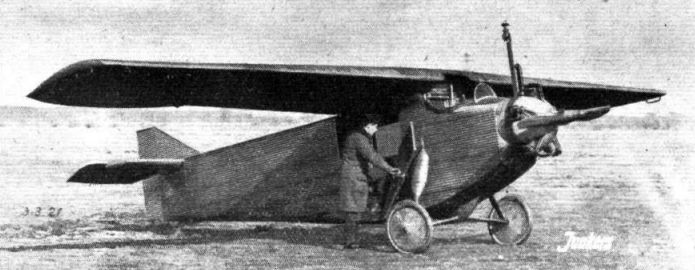Junkers. Самолеты 1920-х годов
Трехместный кабинный моноплан K 16 выпуска 1922 года успеха F 13 не повторил - было построено всего несколько машин.
<...>
Показать полностьюShow all
Flight, August 1923
GOTHENBURG International Aero Exhibition 1923
<...>
The Junkers type K is a small three-seater cabin monoplane, and of Duralumin construction, with corrugated Duralumin covering of both wing and fuselage. The fuselage is very narrow, with only just sufficient elbow-room for the two passengers, who sit facing one another. Although in the type F the wing is placed low, in order to get full advantage of the very strong girder at the root of the wing, it has been placed on top in the type K, mainly because the slightly greater aerodynamic efficiency thus obtained was desired, as the engine is of low power.
The engine fitted as standard to the type K is the Siemens five-cylinder radial of 60 h.p., but the seven-cylinder 80 h.p. Siemens can be fitted if desired. The type K is, like most German commercial machines, so designed that the passengers can step straight into the cabin as they would in a motor-car.
The main data relating to the Junkers type K are: Engine, 60 h.p. Siemens; length o.a., 8 m. (26 ft. 3 ins.); span, 11 m. (36 ft. 1 in.); useful load, 250 kg. (550 lbs.); speed, 125 km. (77 m.p.h.).
<...>
Показать полностьюShow all
Flight, June 1924
THE THIRD INTERNATIONAL AERO SHOW AT PRAGUE
THE GERMAN EXHIBITS
JUNKERS-WERKE, DESSAU
The Junkers type "K" is the same machine exhibited at Gothenburg last year. It is a small three-seater, with two passengers accommodated inside a very cramped cabin, in which there is barely sufficient elbow-room for the two passengers, who sit facing one another, while the pilot is placed ahead of the wing. The engine is a Siemens radial. The type "K" is of usual Junkers construction, with main wing structure of Duralumin tubes, and the fuselage and wings covered with corrugated Duralumin sheet. Minor alterations were noted, such as the substitution of a narrow-chord balanced rudder for the plain rudder fitted at Gothenburg, In other respects the type does not appear to have been altered. The main dimensions are: Length, o.a., 8 m. (26 ft. 3 ins.); wing span, 11m. (36 ft. 1 in.); wing area, 19 sq. m. (205 sq. ft.); weight of machine empty, 500 kgs. (1,100 lbs.); useful load, 250 kgs. (550 lbs.); total loaded weight, 750 kgs. (1,650 lbs.). The maximum speed is 160 kms./h. (99 m.p.h.).
Показать полностьюShow all
Flight, May 1925
THE ROUND-GERMANY FLIGHT
THE MACHINES
The Junkers Machines
The famous German firm of Junkers-Luftverkarhr A.-G., of Dessau, will be represented in the Round-Germany Competition by no less than eight machines, six of which are of their own manufacture, the other two being Focke-Wulf monoplanes fitted with Junkers L.I.A engines of 78 h.p. As a description of the Focke-Wulf machines has been given elsewhere, there is no need to refer to them here except to mention that the Junkers engine is fitted.
Of the six Junkers machines entered four are of well-known types, while the remaining two are of a type specially designed for the Round-Germany flight. Two machines of the K.16 type have been entered and two of the T.26 type. Both of these have previously been illustrated and described in FLIGHT.
The K.16 is a small commercial monoplane with high cantilever wing, and with seating accommodation for two passengers only in a small cabin. The pilot's seat is ahead of the cabin and just in front of the leading edge of the wing. Like all Junkers machines the K.16 is built entirely of metal, mostly Duralumin, but with a few steel fittings for highly stressed parts. Corrugated Duralumin is used for the covering of fuselage and wing. The engine is a Siemens radial of 75 h.p. The main characteristics of the K.16 are: Length o.a., 8 m. (26 ft. 3 ins.); span, 12 -8 m. (42 ft.); wing area, 19 sq. m. (204 sq. ft.). Weight, empty, 535 kg. (1,175 lbs.); useful load, 315 kg. (690 lbs.); total loaded weight, 850 kg. (1,865 lbs.). The top speed is 150 km./h. (93 m.p.h.), and the cruising speed is 120 m./h. (75 m.p.h.). No figures relating to the landing speed are available. The ceiling is approximately 2,500 m. (8,200 ft.).
<...>
Показать полностьюShow all




